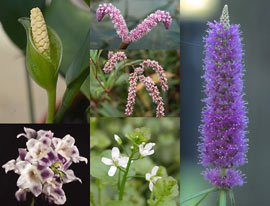Mimosa L.
sensitive plant, sensitive briar, catclaw mimosa (M. pigra)
Fabaceae
Aeschynomene, Neptunia, Sesbania
tropical and subtropical America
M. pigra L.
U.S. Federal Noxious Weed: Mimosa pigra
Identification: Mimosa pigra is closely related to M. pudica (common sensitive plant). It can be distinguished from M. pudica by its large size, large pods (6 to 8 cm long as opposed to 2.5 cm long) and leaves, which have 6 to 16 pairs of pinnaepinna:
(n) one of the primary divisions or leaflets in a compound leaf or frondas opposed to 1 to 2 pairs in M. pudica. M. pigra pods break into individual hairy segments. The seeds are distinctly oblongoblong:
(adj) two to four times longer than wide, with +/- parallel sides, flattened, light-colored, with a wide pleurogram.
Mimosa pigra (giant sensitive plant) is introduced into Africa, Asia and northern Australia.
M. pudica L. is introduced into tropical regions worldwide.
Mimosa pigra L. is considered a serious weed in several countries. It is also a weed on the U.S. federal noxious weed list.
creeping or erect herb or shrub
Perennial. Stem creeping or erect, highly branching, spinosespinose:
(adj) bearing spines
. Leaves compoundcompound:
(adj) with two or more like parts, as in a compound leaf; divided into two or more subsidiary parts or orders, as in a compound inflorescence
(bipinnatebipinnate:
(adj) twice pinnate; having both primary and secondary pinnate divisions
), with 6-16 pairs of leaflets, sensitive to touch (will fold up); petioles and leaves also spinosespinose:
(adj) bearing spines
. Inflorescenceinflorescence:
(n) the arrangement of flowers on the floral axis
 axillary. Flowers in globoseglobose:
axillary. Flowers in globoseglobose:
(adj) spherical or nearly so
heads, pink to purple. Seeds produced in distinctive hairy pods that break into individual one-seeded segments (in M. pigra). Dispersal by vegetativevegetative:
(adj) (1) pertaining to or to the growth of plant organs or plant parts that have nonreproductive functions, such as leaves, roots, stems, etc.; (2) concering non sexual propagules such as tubers, turions, stem fragments, root crowns, rhizomes
fragmentation or of seed pods and pod segments by water or animals.
riparianriparian:
(adj) growing by rivers or streams; of, adjacent to, or living on, the banks of a river, lake, pond, etc.
, littorallittoral:
(adj) of or along the shore
zone, mostly in shallow areas; disturbed areas near water
Mimosa is a large genus of over 700 species, with only a few semi aquatic species. Mimosa pigra, although sensitive, is not nearly as sensitive as M. pudica L.